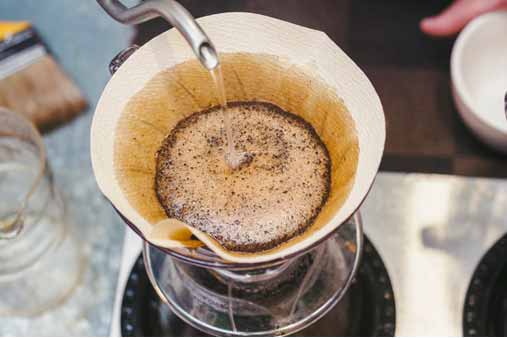What is Third-Wave Coffee?
The phrase “third-wave coffee” puzzles many people and provides a topic of debate for many more. This overview outlines each “wave” or era in American coffee history to give you a better understanding of what third-wave coffee really means.
Recommended: Read our full, in-depth How to Start a Coffee Shop Business guides, inspired by coffee professionals, they will help make your coffee dreams real, from sourcing beans to hiring baristas, choosing the best POS system, forming an actual company, and everything in between.

Before the Third Wave
The First Wave: Late 1800s to 1970
You can probably remember a can of Folgers® coffee either at a family member’s home or perhaps on the counter of an old-school diner. Folgers and Maxwell House® are two examples of the first wave of coffee in which convenience, accessibility, and mass production combined to create a new industry in the late 1800s.
The main characteristic of first-wave coffee — also referred to as “pioneer coffee” — is its intense, dark roast. This roast produced the coffee’s intended flavor rather than needing to rely on the bean itself to provide the desired flavor profile — something people increasingly appreciate today.
The first wave of coffee sparked innovation and discovery in coffee production and distribution, resulting in many of the tools still in use today. For example, coffee producers and distributors established vacuum sealing as a crucial packaging method once they understood that coffee exposed to air loses its freshness and flavor. This time period also gave birth to the automatic coffee maker. Mr. Coffee®, the first mass-produced automatic coffee maker, revolutionized the way Americans made their morning cup. By bringing greater ease and efficiency to coffee-making, this simple appliance helped fuel the modern coffee culture.
Sometimes, however, fast isn’t fast enough. A desire for even greater speed inspired Satori Kato to create instant coffee in 1903. The U.S. military quickly adopted this no-equipment-necessary preparation method during World War I, and it finally made its way into the public sector in 1938 with the development of Nestle’s Nescafe®.
Propelled by these innovations, the coffee industry began to move into the second wave of American coffee culture.
The Second Wave: 1970 to 2000
In the late 20th century, coffee began to shift into a drink people savored out of the public’s desire to understand the origins of their favorite morning beverage. The introduction of espresso drinks into American culture provided a major catalyst for coffee’s second wave.
Cappuccinos and lattes — now common drinks — offered new and exciting ways to enjoy coffee. The addition of flavored syrups and whipped cream, which appeared later in this wave, also helped transform coffee from a simple caffeine delivery vehicle into a treat. In addition, this wave drove major changes to the setting in which Americans consumed coffee. Consumers started to frequent coffee shops, turning a formerly at-home beverage into a social event. As Americans’ interaction with coffee continued to evolve, the environment in which they drank coffee took on greater importance than the coffee itself.
These changes in the typical American coffee consumer coincided with a brand name now synonymous with coffee’s second wave: Starbucks®. Established in 1971, the coffee giant began by serving the freshest coffee possible with an emphasis on the origin and process. This original focus changed quickly when Howard Schultz, a former business partner, purchased Starbucks and transformed it into an incredibly successful business by opening a new store every business day from 1990. By 2000, Starbucks had approximately 3,000 locations nationwide.
The Third Wave: 2000 to the Present
All of this coffee-fueled innovation lead up to coffee’s third wave, in which the concept of single-origin coffees, light roasts, and new coffee processes broke into America’s popular culture. Coined by Trish Rothgeb of Wrecking Ball Coffee Roasters in San Francisco, the term “third wave” defines the current movement toward presentation, traceability, and artisanship in American coffee.
Much like the second wave’s beginning, the changes associated with coffee’s third wave stemmed from consumers’ desire to know even more about the coffee they buy. Today, however, Americans’ interest in traceable coffee extends beyond simply knowing the country of origin into transparency about regions, farms, farmer wages, soil, altitude, and processing methods. For the first time in the history of American coffee culture, consumers developed a knowledge base that informed their palette and changed the quality of mainstream coffee.
Proper presentation and the overall aesthetics of a coffee drink became hallmarks of the third wave of coffee. The simultaneous development of social media also made coffee shops not only a place to spend time but also a photographic setting with beautiful products to match. Drink presentation is one of the key ways this wave continues to change American coffee culture. It encompasses both the dishware used to serve a drink as well as the presentation of the drink itself, which usually includes some form of latte art. This wave also introduced events known as latte art competitions where baristas can showcase their skills and solidify growing respect for the craft of making beautiful drinks.
While spending time in a coffee shop became a common activity in the second wave, the third wave made that time not just an activity, but an event. Beautifully designed cafes with short menus and thoughtfully curated foods became the norm. These changes transformed the humble coffee shop into something resembling a wine bar — further solidifying its place as the new specialty shop to watch.
Several companies played a key role in helping third-wave coffee successfully break into mainstream American culture. Known as “the big three” of third-wave coffee, these brands include Intelligentsia, Stumptown Coffee Roasters, and Counter Culture Coffee. These three pioneers of third-wave coffee lead by example in not only quality and sustainability, but also in consumer education in a way never before done.
What's Next?
As the coffee world continues to thrive in today’s third wave, some industry leaders predict a fourth wave on the horizon. This fast-approaching next phase likely will focus on the root of the world’s favorite beverage: the producers. That focus stems from consumers’ desire to dive even further into the origin of coffee as well as increasing global attention on sustainability. Sustainable coffee farming practices will continue to take on greater importance as climate change dramatically impacts coffee farms, including the potential destruction of crops.
Refining the idea of artisan coffees also could mean coffee shops and roasters source smaller batches from producers or perhaps even a move toward a closer relationship between consumers and producers. Only time will tell what’s in store for this fast-growing — and rapidly evolving — industry.
Now that you've learned all about what Third Wave Coffee is, learn how to Introduce Third Wave Coffee to New Customers.

